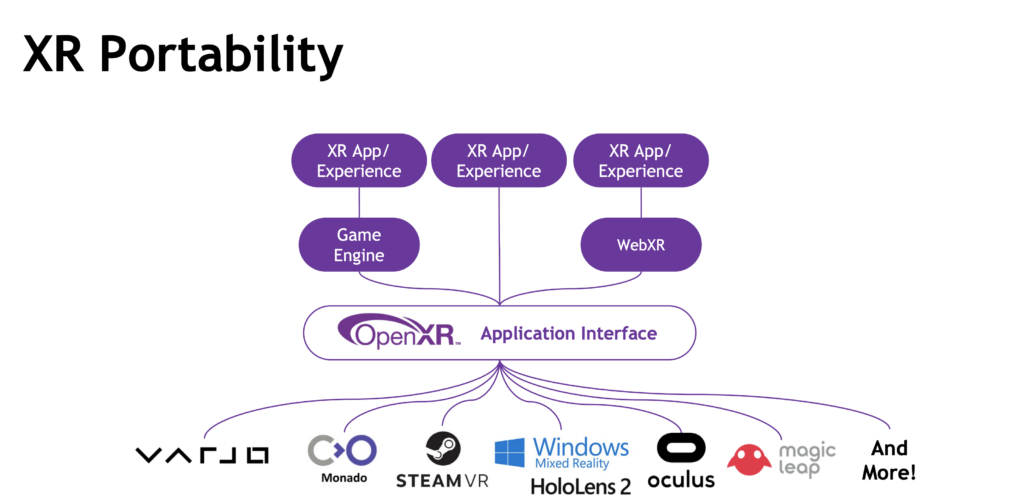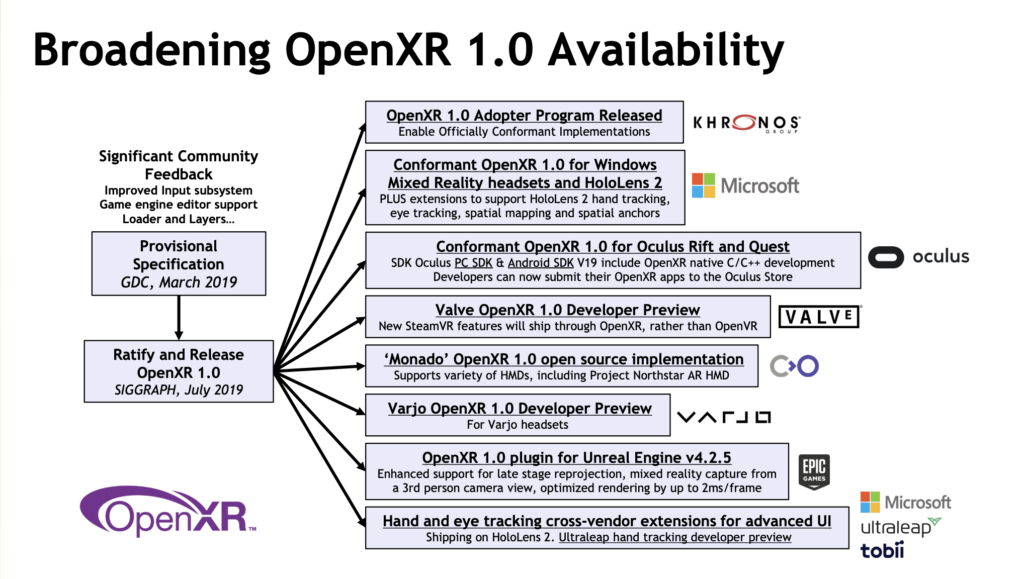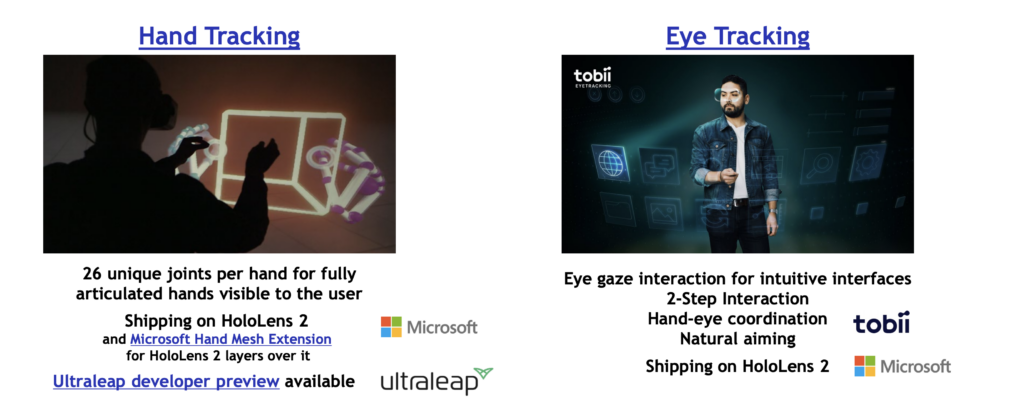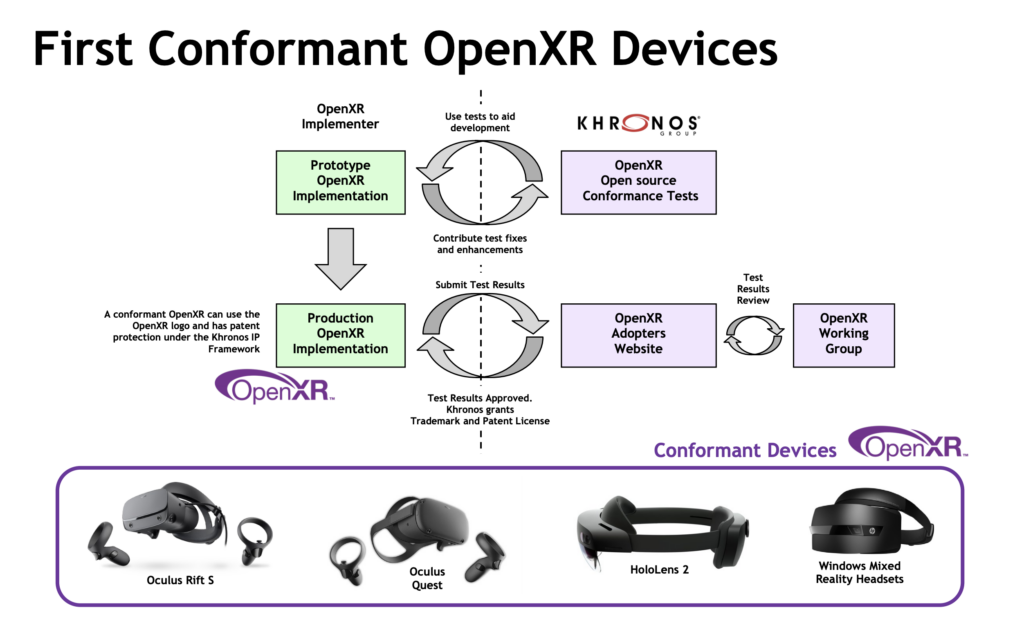Doing what they did for mobile phones, Khronos has stabilized XR.
The headline is:
Khronos announced multiple conformant implementations of OpenXR are shipping from Oculus and Microsoft.
That happened because of the newly opened OpenXR 1.0 Adopters Program and open-source conformance tests, which Khronos announced was coming after launching the OpenXR 1.0 specification last year at SIGGRAPH. Getting something this significant through all the bureaucratic and territorial fiefdoms of two major organizations like Oculus and Microsoft in less than a year is a skill that it seems only Khronos has. It also signals how important this is for the industry. These are just the first two—several more announcements are on the way. And, this is truly an XR announcement in that AR and VR companies are involved and committed.
Portability—OpenXR provides cross-platform, high-performance access directly into XR device runtimes across multiple platforms. (Source: Khronos)
OpenXR is a royalty-free, open standard that provides direct access into XR runtimes across diverse platforms and devices. The OpenXR Adopter’s Program enables consistent cross-vendor testing and reliable operation of OpenXR across multiple platforms and devices with OpenXR-conformant products published on the Khronos Conformant Product Registry.
The path to conformance. (Source: Khronos)
The OpenXR 1.0 Conformance Test Suite has been published as open-source under the Apache 2.0 license on GitHub for continued public development and for use by any company as they implement the OpenXR API on their platform. Any implementers, whether or not a Khronos member, are welcome to become an OpenXR Adopter and submit conformance test results for Working Group review and approval in order to use the OpenXR trademark and gain patent protection under the Khronos Intellectual Property Framework.
History of XR development and extension—and this is just 1.0. (Source: Khronos)
Specific to this first announcement, Khronos members Microsoft and Oculus each have multiple conformant OpenXR-enabled devices showcasing how OpenXR enables portability across diverse platforms. PC-enabled virtual reality devices include Microsoft’s Windows Mixed Reality and Oculus’ Rift headsets, enabling these HMDs, and any future OpenXR-compatible devices, to run the same application executable on Windows. In addition, Microsoft has released an OpenXR-conformant runtime for the HoloLens 2 headset, and Oculus has shipped a conformant runtime for the Android-based Quest, demonstrating OpenXR’s flexibility to enable portable VR and AR applications across standalone and tethered XR devices—using different underlying operating systems.
With the release of the conformance tests and the official launch of the Adopters Program, widening availability of OpenXR across diverse devices, and expanding use in large open-source projects, OpenXR is now ready for developers to take advantage of being able to create truly portable XR applications and experiences.
Steam too
In addition, Valve has released a developer preview implementation of OpenXR 1.0 with new features on SteamVR expected to now appear through OpenXR, rather than OpenVR APIs. Similarly, Varjo’s developer preview implementation of OpenXR enables the use of OpenXR applications with Varjo headsets. The Monado open-source XR runtime founded by Collabora is also growing in compatibility and capability and is approaching conformance with OpenXR 1.0.
Hand and eye-tracking too
In parallel with finalizing the OpenXR 1.0 conformance tests, the OpenXR Working Group continues to push the API forward. OpenXR API layers can be used to implement extensions and the group is also announcing two OpenXR cross-vendor extensions for eye and hand tracking. These new extensions expand the range of advanced UI techniques that can be portably deployed through this cross-platform, cross-vendor API. In fact, Ultraleap has released a developer preview OpenXR integration for its hand-tracking technology for Ultraleap tracking devices.
See and track your hands and your eyes. (Source: Khronos)
“The Working Group has put tremendous effort into OpenXR conformance testing to create a truly reliable cross-platform API. We encourage OpenXR implementers to use the tests in their own development, and consider contributing additional tests to help further reduce cross-vendor variability,” said Brent Insko, working group chair, OpenXR Working Group (and lead XR architect at Intel). “With the release of the conformance tests and official launch of the Adopters Program, widening availability of OpenXR across diverse devices, and expanding use in large open-source projects, OpenXR is now ready for the next wave of adoption and deployment.”
VR voxels and games too
OpenXR enables XR games and applications to target the widest range of hardware with maximum performance. Microsoft announced that Minecraft’s new RenderDragon rendering engine is building its desktop VR support using OpenXR, adding to the OpenXR ecosystem momentum.
Open source projects too
Several open-source projects have also incorporated OpenXR. The free and open-source 3D creation suite, Blender 2.83 has integrated OpenXR to deliver native VR scene inspection capabilities. Google recently released Chromium 81 with OpenXR as its default backend for WebXR, enabling Google Chrome and Microsoft Edge browsers to use any OpenXR-compatible hardware.
Finally, Microsoft has released its OpenXR Samples for Mixed Reality Developers as open-source, demonstrating how to use OpenXR to access the full capabilities of HoloLens 2. The Firefox Reality browser also uses OpenXR to run on the HoloLens 2 platform.
“The time to embrace OpenXR is now,” said Don Box, Technical Fellow at Microsoft. “In the year since the industry came together to publish the OpenXR 1.0 spec and demonstrated working bits at SIGGRAPH 2019, so much progress has happened. Seeing the core platforms in our industry getting behind the standard and shipping real, conformant implementations, as well as coming together to push the spec forward with cross-vendor extensions for critical features like hand tracking and eye tracking is singularly awesome.” Finally, Microsoft has released its OpenXR Samples for Mixed Reality Developers as open-source, demonstrating how to use OpenXR to access the full capabilities of HoloLens 2. The Firefox Reality browser also uses OpenXR to run on the HoloLens 2 platform.
What do we think?
When Khronos got started, a lot of people thought it was just the dumping ground for SGI’s OpenGL and would drift into arcane obscurity as “that standards group.” And had it not been for the noble and self-sacrificing role of Shawn Underwood and Neil Trevett, it might have. But they had a bigger vision, the energy and stamina to see it through and turned a potentially stodgy standards organization into an industry enabling (and one could say saving) connecting glue. The big breakout of Khronos was OpenGL ES which gave a common 3D API to all the mobile device builders and all the conflicting OS and crazy apps that were emerging at the turn of the century. OpenGL ES gave a true and enduring portability to the mobile market and is still serving billions of users today.
OpenXR is history repeating itself, and it, like OpenGL ES, has to be looked at not just for the technical accomplishment, which is historical and astounding, but for welding together so many divergent voices, goals, ambitions, and yes, obstructions. Khronos, led by Trevett, has managed to bring these organizations and people to a common understanding and mutually supportive team.
VR and AR have a lot of critics, who point to the outlandish claims and astounding failures made by some of the suppliers. OpenXR, with Brent Insko as working group chair, will go a long way of neutralizing such abuses and rewarding those who have a real innovation. Khronos has done it again. Thank you Khronos, and thank you, Brent.








